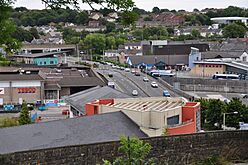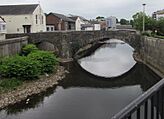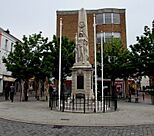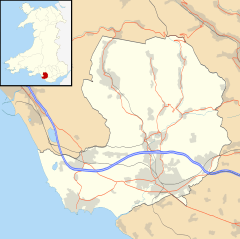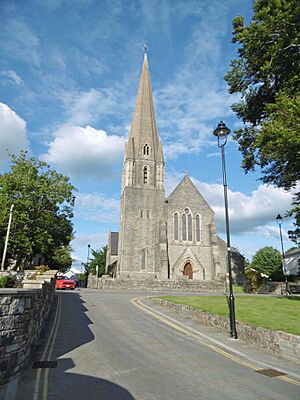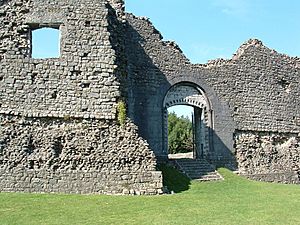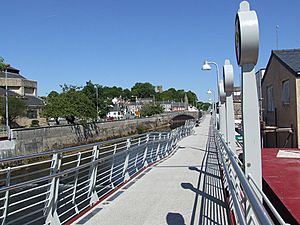Bridgend facts for kids
Quick facts for kids Bridgend
|
|
|---|---|
|
|
| Population | 51,785 (2021 Census) |
| OS grid reference | SS905805 |
| Community |
|
| Principal area |
|
| Ceremonial county | |
| Country | Wales |
| Sovereign state | United Kingdom |
| Post town | BRIDGEND |
| Postcode district | CF31 |
| Dialling code | 01656 |
| Police | South Wales |
| Fire | South Wales |
| Ambulance | Welsh |
| EU Parliament | Wales |
| UK Parliament |
|
| Welsh Assembly |
|
Bridgend (pronounced "brid-JEND") is a town in the Bridgend County Borough of Wales. It's about 20 miles (32 km) west of Cardiff and 20 miles (32 km) east of Swansea. The town gets its name from the medieval bridge that crosses the River Ogmore. Another river, the River Ewenny, also flows through the town.
In 2021, Bridgend had a population of 49,597 people. The town is part of the larger Cardiff Capital Region, which had about 1.54 million people in 2019. Historically, Bridgend was part of Glamorgan. It has grown a lot since the 1980s.
Contents
History of Bridgend
Ancient Times
People lived in the Bridgend area long ago, even before the Romans arrived. Several old burial mounds have been found here. The A48 road between Bridgend and Cowbridge has a part called "Crack Hill." This section is believed to be an old Roman road. The Vale of Glamorgan was a natural path for Romans traveling west to the fort at Neath from places like Cardiff.
Norman Invasion
After the Normans took over England in 1066, they started looking to expand into Wales. Norman lords came to Wales and built castles to control the land.
At Coity, a Welsh leader named Morgan Gam already had a strong base. In the 11th century, a Norman lord, Payn de Turberville, wanted to take over Coity Castle. Morgan Gam agreed, but only if Turberville either fought him or married his daughter, Sybil. Turberville chose to marry Sybil and became the Lord of Coity, rebuilding the castle.
Other castles were built nearby too. Newcastle Castle (built in 1106) and Ogmore Castle (built in 1116) were important Norman strongholds. About 2 miles (3 km) away from Ogmore Castle, Ewenny Priory, a fortified religious building, was founded in 1141. These three castles and the priory formed a strong defensive area.
How the Town Grew
Bridgend started as a place where people could cross the River Ogmore easily. This crossing was on the main route between eastern and western Wales. North of the town, three rivers meet: the Ogmore, the Llynfi, and the Garw. South of Bridgend, the River Ewenny joins the Ogmore before flowing into the Bristol Channel.
In the 15th century, a stone bridge was built over the Ogmore. It originally had four arches, but a big flood in the 18th century washed two away. The rest of the bridge still stands and is a key part of the town. It was repaired in 2006.
Bridgend quickly grew into a farming town and became an important market town. It kept this status until the late 20th century.
Industrial Growth
The discovery of coal in the South Wales Valleys to the north greatly changed Bridgend. Coal mining began in the 17th century, with the Llynfi Valley being one of the first areas to become industrial. Bridgend itself didn't have coal, but the valleys became a major part of the South Wales coalfield. Ironworks and brickworks also started up.
The Great Western Railway came to Bridgend, making it a hub between the main London to Fishguard line and the branch lines to the three valleys. Coal trains often carried coal down the valleys. Later, the Vale of Glamorgan railway allowed coal to be sent directly to ports like Barry or Porthcawl.
Several quarries opened near Bridgend town centre. An engine works and a larger farmers' market also opened. In 1801, the area had about 6,000 people. By the early 1900s, this grew to 61,000. Bridgend was a busy market town with thriving industries.
World War II and Beyond
During the Second World War, Bridgend had a prisoner of war (POW) camp called Island Farm. There was also a huge munitions factory (ROF Bridgend) at Waterton and a large underground storage base at Brackla. At its busiest, the factory had 40,000 workers, many of them women.
In 1945, 67 POWs escaped from Island Farm through a tunnel, but they were all caught. Even though Bridgend was important during the war, it was never heavily bombed. This was partly because of a natural "air pocket" that made bombing very difficult for planes.
After the war, Bridgend remained a strong market town. In 1948, the National Eisteddfod, a major Welsh cultural festival, was held in Newbridge Fields.
In 1960, the River Ogmore flooded the town centre. To prevent future floods, concrete walls were built along the riverbanks. Bridgend was also chosen as the headquarters for South Wales Police because of its central location between Swansea and Cardiff.
In the 1970s, Bridgend began its biggest growth period. The M4 motorway was built around the town, and the Waterton factory was turned into an industrial estate. Major companies like Ford and Sony set up factories there.
During the 1980s, new housing areas like Brackla and Broadlands caused Bridgend's population to grow a lot. This led to more traffic and parking issues. In 1997, a new road was built to connect the town centre directly to the M4 motorway and help traffic flow better. A new prison, HM Parc Prison, opened near Coity in 1997. The McArthur Glen Designer Outlet also opened in 1998.
New Millennium
In the 2000s, money was invested to improve the town centre. Some areas became pedestrian-only, and old buildings were restored. A new bus station was built in 2004, and traffic routes were changed. The town started holding events like Continental Markets and Celtic Festivals, which brought many visitors and boosted the local economy.
A new walkway was built along the River Ogmore in 2009, creating a pleasant "riverside cafe culture."
Future Plans
Construction started in 2011 on a large new housing area called Parc Derwen near Coity, planned to have 1,500 homes. The local council is also looking into ways to bring bigger shops to the town centre and improve areas like Elder Yard with new restaurants and shops.
People of Bridgend
Population and Background
According to the 2021 Census, Bridgend and its urban area had 51,785 people. Most residents were White (94.9%), with smaller percentages of Asian (2.5%), Mixed (1.7%), Black (0.5%), and other ethnic groups (0.1%).
When it comes to religion, 54% of people said they had no religion. Christianity was followed by 43.6% of the population. Other religions included Islam (1%), Buddhism (0.4%), Hinduism (0.3%), Sikhism (0.1%), and Judaism (0.1%).
Bridgend's Economy
Bridgend has bounced back well from the decline of older industries like coal mining. It now has many different types of jobs, and wages are generally higher than in other parts of the South Wales valleys. There are large industrial areas at Bridgend and Waterton, home to many small and large manufacturing companies.
The Ford engine plant near Waterton was one of the biggest employers, making "EcoBoost" engines. Ford invested a lot of money in this plant, which was praised as a "world-beating" factory. However, the Ford plant closed in September 2020.
Other companies in Bridgend include CGI (an IT company), Lidl (which has its Welsh headquarters here), Zoobiotic (a company using maggots for medical therapy), and Winmau, a famous dartboard maker. Ortho-Clinical Diagnostics, Staedtler, Skanska, TES Aviation, and Dekor plc also have operations here. Photronics Inc, a company making semiconductor photomasks, has been at Ewenny Science Park for 20 years.
However, some companies have left or downsized, like Sony and Wrigley Company.
Bridgend has many jobs in retail. In 2008, 13,100 people worked in construction and manufacturing, while 42,900 worked in the service sector.
Shopping Areas
In the town centre, you can find shops in places like the Rhiw Shopping Centre (which includes Bridgend Market), Adare Street, Caroline Street, and Cheapside. These areas are close to the bus and railway stations.
Outside the town centre, there are shopping areas at Waterton, on Cowbridge Road, and at The Derwen, near Junction 36 of the M4. This is where the Bridgend Designer Outlet is located.
Getting Around Bridgend
Trains
Bridgend railway station has regular train services. You can travel east to Cardiff Central, Bristol Parkway, and London Paddington. To the west, trains go to Port Talbot Parkway, Neath, Swansea, and further along the West Wales Line. North of Bridgend, trains go to Maesteg. There are also services to Manchester Piccadilly. Bridgend is the end point of the Vale of Glamorgan Line, which reopened for passengers in 2005.
Wildmill railway station, about 1 mile (1.6 km) north of Bridgend station, serves the Wildmill, Pendre, and Litchard areas. A new park-and-ride station is planned for Brackla.
Buses
Bridgend bus station offers bus services to many urban and rural areas in South Wales. Most services are run by First Cymru.
Cycling
There's an east-west cycle route from Brackla to Broadlands and Cefn Glas. Bridgend is part of the National Cycle Route, with paths leading to the town centre from the Celtic Trail. The Afan Valley, about 12 miles (19 km) north of Bridgend, is famous for its mountain bike trails, which are considered some of the best in Europe.
Air Travel
For flights, Bridgend is served by Cardiff International Airport. You can get there by direct train or bus services.
Learning in Bridgend
Bridgend town has four comprehensive schools: Archbishop McGrath Catholic Comprehensive, Brynteg Comprehensive School, Bryntirion Comprehensive School, and Pencoed Comprehensive School. Brynteg is well-known for its rugby players, including famous names like J.P.R. Williams and Gavin Henson. Many talented athletes choose Brynteg to play in Welsh school rugby leagues. Bryntirion has also produced sports stars like Gareth Llewellyn. Archbishop McGrath School serves the whole county and moved to a new campus in Brackla in 2011.
There are also at least nine primary schools in the town.
Two special-educational needs schools are in Bridgend: Heronsbridge School for students with severe learning disabilities, and Ysgol Bryn Castell for students with moderate to severe learning disabilities.
Bridgend College is the town's college for further and higher education. It offers vocational courses and GCSEs, attracting students from as far as Swansea and Cardiff. It also has higher-education courses like Higher National Certificates and Higher National Diplomas, often linked with the University of South Wales. The college has campuses focusing on different subjects, like sport and animal care at Pencoed. Bridgend College also has a place for students aged 16 and over with learning difficulties who come from all over Wales.
Culture and Fun
Nightlife
Bridgend town centre has several pubs, restaurants, and a nightclub. In 2008, Bridgend Council created an alcohol-free zone in the town centre to help with alcohol-related issues. CCTV cameras watch over the town centre, and police are usually present. Since 2007, Street Pastors also patrol the streets on Friday and Saturday evenings, helping people.
Music Scene
Bridgend has produced famous music acts. Bands like Funeral for a Friend, Jayce Lewis, and Bullet for My Valentine have gained national and international recognition. Smaller venues in the town also host open-mic nights. Bryan Adams performed for 15,000 people at the Brewery Field stadium in 2006. The Recreation Centre has hosted bands like Fall Out Boy and Bring Me the Horizon.
Eisteddfodau
Bridgend hosted the National Eisteddfod in 1948. The Bridgend County area also hosted the Urdd Gobaith Cymru National Eisteddfod in 2017, which is a major youth cultural festival.
Local Media
Bridgend receives television signals from the Wenvoe TV transmitter. Several local radio stations serve the area, including Bridge FM, Heart South Wales, and Nation Radio Wales. The main local newspaper is The Glamorgan Gazette.
Twin Towns
Bridgend has twinning agreements with:
 Langenau, Germany
Langenau, Germany Villenave-d'Ornon, France
Villenave-d'Ornon, France
Sports in Bridgend
Rugby Union
Bridgend Ravens Bridgend Ravens are a semi-professional rugby union team formed in 1878. They play in the Welsh Premier Division at the Brewery Field. The club has won the Welsh championship five times and the WRU Challenge Cup twice. They have also played against international teams, beating Italy, Western Samoa, and Australia.
Bridgend Athletic Bridgend Athletic RFC was reformed in 1972. They have been promoted through various leagues and currently play in WRU Division One West.
Bridgend Sports Bridgend Sports Rugby Football Club was formed in 1938. They are a member of the Welsh Rugby Union and play in the WRU Division Four South East. They won the Glamorgan County Silver Ball Trophy three times in a row from 1979 to 1981.
Celtic Warriors The Celtic Warriors were a regional rugby union team formed in 2003, mainly based at the Brewery Field. They were created when Bridgend RFC and Pontypridd RFC merged. However, the team was dissolved after just one season due to money problems.
Ospreys Rugby The Ospreys team was formed in 2003. Bridgend became part of this region after the Celtic Warriors disbanded. Although the Ospreys usually play in Swansea, they have played some of their Anglo-Welsh Cup home games at the Brewery Field since 2010.
Football
Bridgend used to have two football teams, Bridgend Town A.F.C. and Bryntirion Athletic F.C.. In 2013, these two clubs joined to form Pen-y-Bont F.C.. Following their promotion in 2019, they now play in the Cymru Premier, which is the top level of Welsh football.
Because of Bridgend's location, many football fans in the town support either Cardiff City or Swansea City.
Rugby League
Bridgend was home to the Super League rugby league team, the Crusaders. They played at the Brewery Field. In 2009, the Crusaders joined the Super League, but later moved to Wrexham.
Bridgend's other rugby league team is the Bridgend Blue Bulls. They are one of the UK's most successful amateur clubs, having won two national amateur titles and been Welsh Champions five years in a row.
Other Sports
Bridgend has local cricket clubs, a men's and women's hockey club, golf courses, and facilities for tennis and bowls at the Bridgend Lawn Tennis and Bowls Association.
Famous People from Bridgend
- Aneurin Barnard (actor)
- Nicole Cooke (cyclist)
- Huw Edwards (journalist and newsreader)
- David Emanuel (fashion designer)
- Scott Gibbs (rugby union player)
- Mike Hall (rugby union player)
- Gavin Henson (rugby union player)
- Robert Howley (rugby union player)
- Dafydd James (rugby union player)
- Marc Jenkins (Olympic triathlete)
- Carwyn Jones (politician, former First Minister of Wales)
- Ruth Jones (actress)
- Jayce Lewis (musician/producer)
- Gareth Llewellyn (rugby union player)
- Josh Navidi (rugby union player)
- Ryan Day (snooker player)
- Owen Teale (actor)
- Gareth Thomas (rugby union and league player)
- Helen Tucker (World Triathlon champion)
- Matthew Tuck (Singer)
- Rhys Webb (rugby union player)
- J. P. R. Williams (rugby union player)
Bands from Bridgend
- Bullet for My Valentine
- Jayce Lewis
- Hondo Maclean
- Funeral for a Friend
- The Featherz
- The Partisans
See also
 In Spanish: Bridgend para niños
In Spanish: Bridgend para niños


